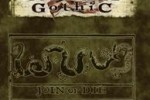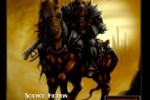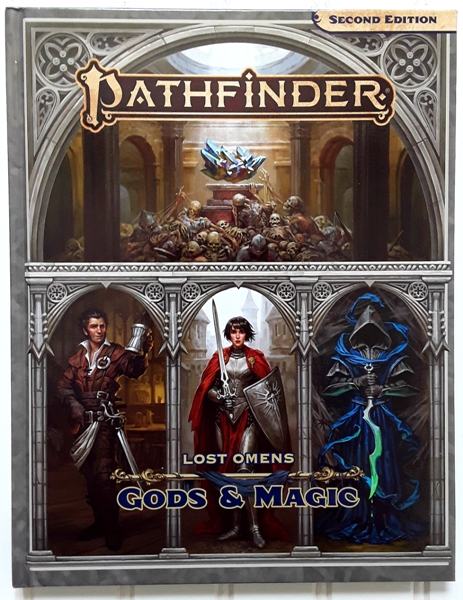Colonial Gothic: Gazetteer
Gazetteer is a supplement for the alternate history, colonial America, low fantasy, horror system Colonial Gothic (powered by the 12° system) published by Rogue Games and written by Graeme Davis.
By Aaron T. Huss
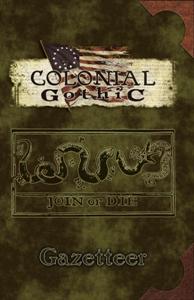
Gazetteer is the quintessential colonial America sourcebook for Colonial Gothic. It states, quite simply, what has been going on within the different colonies throughout the course of colonization up to the Revolutionary War. At its roots, Gazetteer seems like a historical book, but when you read soak up the content, you realize that it’s filled with adventure seeds, major characters, major encounters, campaign frames and background information that makes for great game-play. The key is to take the information and translate it into in-game situations. In addition, the Flames of Freedom campaign finds its beginnings within this sourcebook.
HISTORY
Gazetteer starts with a high-level view of some of the events that occurred during the period of time within the thirteen colonies starting from colonization to the Revolutionary War. This includes a look at who was colonizing the new territories, where those territories were located, conflicts local to the colonies, wars abroad and their influence upon the colonies, and some of the various acts that lead up to the Revolutionary War like the Stamp and Tea Acts. This is a very good introduction to the content and really helps to frame what is found inside.
THIRTEEN COLONIES
The majority of Gazetteer is comprised of the content pertaining to the thirteen colonies. This is divided into thirteen different sections all containing the same grouping of information: first settlement, (1775) capital, economy, native tribes, (1775) Governor, time-line of major events, geography, major locations, and mysteries. The key areas for in-game adventures and campaigns is contained within the time-line and the mysteries section. The remaining content is source material that can be used for backgrounds, major NPCs and aiding the GM in establishing where things are.
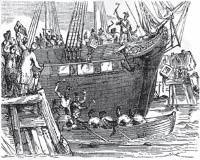
The mysteries listings for each colony contains a list of folklore stories that are geared toward the themes within Colonial Gothic. Each mystery is short and vague but provides enough information for the GM to start creating an adventure or encounter around or directly using that information. But what about the time-line? This is significantly less obvious, especially when taken at face value. It is, after all, a simple time-line of the major events that occurred historically – actual events. So what does this mean? It provides the GM with a written list of actual, historical conflicts that can be turned into adventures, encounters or used as part of an ongoing campaign. And given that they cover around 200 years of time, the GM has the ability to create adventures and campaigns within any decade desired.
I don’t normally do this, but an example will demonstrate this… The following is an entry for Massachusetts.
1721: Smallpox outbreak in Boston infects 6,000 of the population of 11,000, killing 488.
A GM could translate this into a plague brought forth by the frequent appearance of deep ones throughout the area. The deep ones have been attacking unwary citizens at night, leaving their rotting corpses within nearby marshlands. Rats flock to these corpses and begin feasting. They become infected with this plague and quickly bring it into the city. – You have the seeds for an adventure in which your PCs are left to investigate the source of the plague and extinguish the attacking deep ones. But as I said before, you have to translate the information into in-game possibilities and not simply take it at face value.
NATIVE AMERICANS
Lightly introduced and referenced throughout the core rulebook and various publications, there are a number of different native American tribes described throughout in different ways. Gazetteer dedicates a full section to introducing and giving additional, basic information on the various tribes encountered throughout colonization. The difference here is the amount of tribes described. There are two groups described: Algonquin and Iroquoian. Within these groups are further descriptions of the different tribes attributed to those groups such as Wampanoag, Mohegan, Mahican, Cherokee, and many more. Many of the references within the thirteen colonies sections pertain to these different tribes and thus a description is provided to give more detail.
ADVENTURE
Gazetteer finishes up with a single adventure that leads into the Flames of Freedom campaign (although it doesn’t have to). The heroes find themselves entering Boston and becoming a part of the Revolutionary War. But that’s all I’m going to say.
OVERALL
I will admit that I was very skeptical when starting to read through Gazetteer. I was confused by the lack of Colonial Gothic content while, at the same time, being intrigued by all the historical source material. Then I read through the adventure and it all came together. Colonial Gothic is not just a game about fantasy and horror during the colonial period of America, it’s also about immersing the players in historical events that were not as they truly seemed (or rather how they were documented). While reading through the adventure, I began to realize that creating an alternate history in whatever fashion desired is a key part to Colonial Gothic. This allowed me to look at the content in a different way. These are events recorded in history and as the GM, you can create the why, how, and what and then allow the PCs to determine the outcome. However, if it wasn’t for the adventure, I may not have made that connection and may have struggled to find the source material within the historical information.
RATINGS
Publication Quality: 8 out of 10
The Colonial Gothic line of publications from Rogue Games always has great layouts, presentations and illustrations. While Gazetteer generally follows this, I feel there is too much white space and an example of how to translate historical facts into Colonial Gothic fiction would be helpful. There are not many illustrations within the book, but then it doesn’t really need it. As a gazetteer of each colony, a map is often all you need. All-in-all, it’s a great looking publication that follows the fantastic presentation methods found throughout the Colonial Gothic line.
Mechanics: 7 out of 10
While there are no direct in-game mechanics introduced within Gazetteer, the publication pinpoints historical information that is useful within the given mechanics of the Colonial Gothic setting. Again, this is not obvious at first and requires a bit of translation. But once you do some quick translation and get that “ah-ha” moment, you’ll realize how much content is presented within that can take full advantage of the Colonial Gothic mechanics. However, it’s the translation part that may trip some GMs and make them wonder why this content is useful. Again, an example would really help to make that leap from simple historical facts to in-game content.
Value Add: 9 out of 10
I will make this statement quite boldly: Once you figure out how to use Gazetteer, you will realize how valuable it is as a sourcebook. There is a plethora of information that can be used in a number of ways throughout a variety of adventures and campaigns. From the mundane background of your non-player character to framing a full campaign, Gazetteer really covers a lot. And I recommend reading through the adventure module at least once if not twice to fully understand how that information becomes valuable.
Overall: 8 out of 10
I’m a big fan of source material that gives GMs the freedom to use that material in any fashion they see fit. But often times source material can become buried within itself if it is not obvious how that material translates into in-game effects. While Gazetteer is filled with fantastic source material, it definitely did not feel that way at first. But give it a second look if necessary and start reading between the lines to find the true value of that material. It is, in my opinion, a very valuable sourcebook for GMs, especially those who need some ideas for writing their next adventure.
